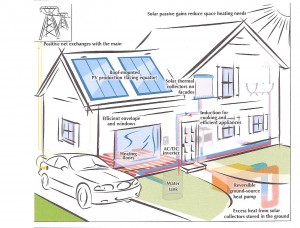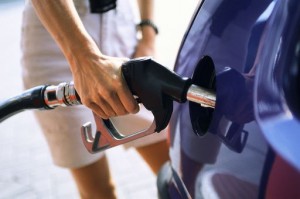Since the end of 2018, the « energetic and ecological transition » has clearly been navigating in the troubled waters of a formidable Bermuda triangle from which it struggles to emerge, delineated by: the debate over the role of the carbon tax, the revision of the so-called PPE « Multiannual Energy Programming » (PPE), and « the Case of the century » (a legal action against the State accused of climatic negligence). France has made commitments over the past ten years to fight against global warming by sharply reducing its greenhouse gas emissions, particularly those of CO2, which are written objectives (the Paris agreement at the end of Cop 21, and the vote on the Energy Transition for Green Growth Act, both in 2015, being the highlights). The violent shakings that the French energy strategy is undergoing and the fact that after falling quite regularly between 1990 and 2014, France’s CO2 emissions increased by 3% between 2014 and 2017 (transport and buildings are responsible for this) show that the mobilized resources are either insufficient or inadequate (meanwhile figures for 2018 are better as emissions have been reduced).
The OFCE (Observatoire Français des Conjectures Economiques) draws a warning signal in a note, saying that « being 90% inefficient today, the French ecological strategy must be thoroughly reviewed and corrected » (E. Laurent, OFCE, « The French ecological transition: from entrapment to embedding « , Policy Brief, 52, 21 February 2019, www.ofce.sciences-po.fr/publications/policy.php ). This diagnosis is perhaps severe and we present our own assessment, recalling firstly the energy strategy objectives. The reduction in the final energy demand, primarily in buildings and secondarily in transport, respectively 43% and 32% of the final energy expenditure in France, is a key objective enshrined in the 2015 law and in the PPE which is being revised. It plans : – a 40% reduction in the fossil fuels consumption by 2030 (instead of the 30% stipulated by the 2015 law) –an annual increase for financial State commitments for the energy transition from 5 to 8 billion euros – a continuation of financial public support for electric vehicles purchase to 6000 € per vehicle. The fight against energy poverty  (affecting 5 million households) is also an important objective of the plan, the energy check intended to help households in precarious situations paying their energy bills will be increased to 200 € / year, in 2019. Let remember to be complete (see our January blog Electricity: energy of the future) that the revised PPE plans : – that the goal of decreasing from 75% to 50% of the share of nuclear power in electricity production will be postponed to 2035 (instead of 2025) – a sharp rise in electricity generated by renewable energy sources (40% of electricity production in 2030), coal-fired power plants having to stop before 2022.
(affecting 5 million households) is also an important objective of the plan, the energy check intended to help households in precarious situations paying their energy bills will be increased to 200 € / year, in 2019. Let remember to be complete (see our January blog Electricity: energy of the future) that the revised PPE plans : – that the goal of decreasing from 75% to 50% of the share of nuclear power in electricity production will be postponed to 2035 (instead of 2025) – a sharp rise in electricity generated by renewable energy sources (40% of electricity production in 2030), coal-fired power plants having to stop before 2022.
With regards to this balance sheet, it is clear that the final energy consumption (157 Mtoe) did not yet decreased, it was stable in 2017 (it even increases by 1.5% at constant climate, and by 1% for transport, Energy Balance of France 2017, February 2019, www.statistiques.developpement-durable.gouv.fr ) and it has declined only slightly since 2010. As for household energy expenditure, it increased by 4.4% in 2017 (it amounted to € 2900, i.e. 52% for housing and 48% for transport). While the renewable energies share in final energy consumption has increased significantly from 9.3% in 2006 to 16% in 2016, the objective of pushing its part to 20% by 2020 will be difficult to achieve. With regard to CO2 emissions from fossil fuels, which have been declining steadily since the beginning of the century, they have rebounded since 2014 (an increase of 1.8% at a constant climate in 2017, but with a decrease in 2018). Overall, the energy policy is not on a trajectory that would allow it to achieve the objectives of the 2015 law and to meet the commitments made for the climate, a situation denounced by the signatories of the petition bearing the « Case of the century ».
This assessment also reveals that the energy poverty of many households has not decreased, the rise in fuel prices, targeted by the first demonstrations of the so-called “yellow vests”, does not help overcoming it and the weakness of the amount of the energy check (200 €) does not render possible a significant energy bill reduction for its beneficiaries; energy poverty is the main social dimension of the energy strategy that it has not been sufficiently taken into account. It should also be recalled that the Parliamentary Office for the Evaluation of Scientific and Technological Choices made a severe assessment of the thermal renovation of buildings, which is certainly an efficient means for energy saving (OPESCT, JL Fugit and L. Prud’homme, note scientifique, July 2018, www.senat.fr/opects ): the energy law had planned for this thermal renovation at a level of 500,000 lodgings per year (an expensive operation costing at least € 20,000 per unit), but the results obtained, despite the importance of the committed resources (3.8 billion incentive credits in 2015), for the energy consumption reduction has been very low, from 498 TWh to 493 TWh from 2009 to 2016, a 1% decrease !
To this already heavy balance we can add three elements. The first one is the health impact of urban pollution (see the OFCE note): in several French cities exposure to fine particles – notably the PM 2.5 (emitted by diesel engines) – is higher than the WHO risk threshold (this is the case in Grenoble, Le Havre, Lyon Marseille, Nice, Paris …). This pollution would cause about 48,000 annual deaths in France. The requirement of « Crit’air » traffic vignettes for vehicles adopted in Grenoble and Paris is an efficient parade (pending the advent of electric mobility) but still limited, the responsibility of which resting on municipalities. The second one is the inconsistency of the industrial policy to support the energy transition in a number of areas: energy efficiency, renewable energy infrastructure and electricity networks, a quasi Bérézina for the nuclear industry and oil services, long delay for initiating a batteries industry … The third one, finally, is the paradoxical statement that despite all the political statements about the importance of R & D and innovation for energy, national public R & D expenditures  have been steadily decreasing since 2012: they amounted to € 973 million in 2017, 5% of total public R&D expenditures, a 2% decrease compared to 2016, and on average of 3% per year between 2012 and 2015 (see Commissariat General au Développement Durable, dépenses publiques de R & D pour l’energie in 2017, February 2019, www.statistiques.developpement-durable.gouv.fr/publications/…/depenses-publiques-rd ). Nuclear energy represents 53% of expenditures and new energy technologies 33% and if those in favor of the latter have quadrupled between 2002 and 2011, they have since dropped (-10% in 2017): a short-sighted policy….
have been steadily decreasing since 2012: they amounted to € 973 million in 2017, 5% of total public R&D expenditures, a 2% decrease compared to 2016, and on average of 3% per year between 2012 and 2015 (see Commissariat General au Développement Durable, dépenses publiques de R & D pour l’energie in 2017, February 2019, www.statistiques.developpement-durable.gouv.fr/publications/…/depenses-publiques-rd ). Nuclear energy represents 53% of expenditures and new energy technologies 33% and if those in favor of the latter have quadrupled between 2002 and 2011, they have since dropped (-10% in 2017): a short-sighted policy….
Against this balance sheet what can be done? The goal of getting out of carbon energies has to be maintained even if we have to admit that it will take several decades to reach it. A number of social and technical priorities are needed: – the fight against energy poverty – the transition to electric mobility associated with the fight against urban air pollution – a secure electricity mix combining renewable energies and nuclear energy, efficient electricity storage (the issue of batteries) – an amplification of the R & D effort associated with an industrial strategy to prepare the future. The State budget is under tension and the issue of carbon tax has been on the agenda of the national debate launched by the President of the Republic. A carbon tax, applied today in many countries, was set up in France in 2014 by the Prime Minister J-M. Ayrault after many tribulations (including constitutional), following the proposal of a committee chaired by Michel Rocard, in 2009. This tax on CO2 emissions by fossil fuels was a contribution to an action “energy-climate”, it should be redistributed and re-evaluated periodically. It amounted to 44.6 € / ton of CO2 in 2018 and the government decided to maintain its level in 2019, following the movement of yellow vests, it « yielded » 9.1 billion euros in 2018. To complicate matters, it will be observed that the carbon tax has been incorporated into an internal consumption tax on energy products (TICPE whose ancestor dates back to 1928 …) which has globally generated 33.8 billion euros before tax in 2018 (gasoline SP 95 E-10 is thus taxed at 66.3 c € / liter, and diesel at 59.4 c € / l, with a respective contribution of the carbon tax of 7 c € / l and 8 c € / l, the disparity will be corrected). Let us add that electricity is also taxed, notably via the “Contribution to the public utility of electricity”, the CSPE (7 billion euros in 2018 have been devoted as a compensatio n for the additional cost of renewable electricity). Thus the TICPE is redistributed for a third to local authorities and it abounds an account for the support of the energy transition (€ 5.2 bn in 2018 financing the extra cost of renewable energy) and a fund for transport infrastructures (€ 1bn) in 2018). Contrary to popular belief, France is not the country that taxes the most fuels: they represent 64% of the price of fuel against 68% in the Netherlands, No 1 in the EU, 66% in the United Kingdom and 65% in Germany. Lastly, last but not least, the Committee on the « tutelary value of carbon », the so-called Quinet commission, which assesses the application of the carbon tax, actually an « ecotax », proposed in February to increase its amount to 250 € / ton of CO2 in 2030 (in 2008 it had forecasted an amount of 100 € / ton). It should help achieving the objectives of the fight against global warming, the « carbon neutrality » around 2040. Implementing the carbon tax increase will require fingering, including compensation for the professional use of vehicles (see the IDDRI note, M. Saujot, N. Berghmans, L. Chancel, « After the freezing of the carbon tax, what priorities for the ecological transition? », Propositions, No. 01, March 2019, www.iddri.fr ).
n for the additional cost of renewable electricity). Thus the TICPE is redistributed for a third to local authorities and it abounds an account for the support of the energy transition (€ 5.2 bn in 2018 financing the extra cost of renewable energy) and a fund for transport infrastructures (€ 1bn) in 2018). Contrary to popular belief, France is not the country that taxes the most fuels: they represent 64% of the price of fuel against 68% in the Netherlands, No 1 in the EU, 66% in the United Kingdom and 65% in Germany. Lastly, last but not least, the Committee on the « tutelary value of carbon », the so-called Quinet commission, which assesses the application of the carbon tax, actually an « ecotax », proposed in February to increase its amount to 250 € / ton of CO2 in 2030 (in 2008 it had forecasted an amount of 100 € / ton). It should help achieving the objectives of the fight against global warming, the « carbon neutrality » around 2040. Implementing the carbon tax increase will require fingering, including compensation for the professional use of vehicles (see the IDDRI note, M. Saujot, N. Berghmans, L. Chancel, « After the freezing of the carbon tax, what priorities for the ecological transition? », Propositions, No. 01, March 2019, www.iddri.fr ).
Without embarking into a fiscal Monopoly, let us identify some ways to finance the energy transition, via energy taxation of energy, including that of carbon. The reassessment of the amount of the energy check should be a priority (a minimum amount of € 500?), financed by an endowment abounded by the carbon tax (and therefore the TICPE) and the CSPE. The thermal renovation of buildings should be able to benefit from much greater support (subsidy or tax credit and a zero-rate loan system). A specific fund could be cre ated for this purpose either at the Caisse des dépôts et consignations or within agencies created by the regions to drive their energy policy (and possibly ensuring the payment of the energy check). Support for electric mobility should be ensured both by a subsidy for the purchase of electric vehicles, the cost of which will be increased for the State budget, and by assistance to local authorities for the construction of a public network of fast charging stations (funded through regional agencies). According a recent report « technological scenarios to achieve the objective of stopping the commercialization of thermal vehicles in 2040 » published by OPECST (note OPECST, March 2019), the transition to electric mobility would allow reducing vehicle CO2 emissions by a factor of 5, but its total cost would reach five hundred billion euros (including € 31-108 billion euros for charging stations). Finally, R & D and training for the energy professions should be able to benefit from specific financial means, via the carbon tax, through an increase in the ADEME budget and budgetary allocations to regional agencies in charge of research, innovation and higher education. In the same way, over the years, an increase in the capital endowment of the Public Investment Bank (BpiFrance) should allow it to invest in companies in the energy sector. Tax incentives will have to be limited in the medium term, especially as carbon tax revenues will dry up. The new deal for the energy strategy is largely based on administrative decentralization, it supposes that the regions prune their institutional maquis of regional agencies and structures in charge of economic development, innovation and research.
ated for this purpose either at the Caisse des dépôts et consignations or within agencies created by the regions to drive their energy policy (and possibly ensuring the payment of the energy check). Support for electric mobility should be ensured both by a subsidy for the purchase of electric vehicles, the cost of which will be increased for the State budget, and by assistance to local authorities for the construction of a public network of fast charging stations (funded through regional agencies). According a recent report « technological scenarios to achieve the objective of stopping the commercialization of thermal vehicles in 2040 » published by OPECST (note OPECST, March 2019), the transition to electric mobility would allow reducing vehicle CO2 emissions by a factor of 5, but its total cost would reach five hundred billion euros (including € 31-108 billion euros for charging stations). Finally, R & D and training for the energy professions should be able to benefit from specific financial means, via the carbon tax, through an increase in the ADEME budget and budgetary allocations to regional agencies in charge of research, innovation and higher education. In the same way, over the years, an increase in the capital endowment of the Public Investment Bank (BpiFrance) should allow it to invest in companies in the energy sector. Tax incentives will have to be limited in the medium term, especially as carbon tax revenues will dry up. The new deal for the energy strategy is largely based on administrative decentralization, it supposes that the regions prune their institutional maquis of regional agencies and structures in charge of economic development, innovation and research.
The balance sheet of the French energy strategy is certainly not catastrophic, meanwhile it is not satisfactory and it must be taken out of the Bermuda triangle in which it sails to prevent it from failing or shipwreck. State has major responsibilities because it is he who sets the course but he is not alone. Local authorities have their own one because energy efficiency is highly dependent on the existence of efficient infrastructure (public transport and urban development) and land policies avoiding energy-consuming with urban sprawl. Citizens also have one, because mitigating climate change requires a change in lifestyle that will be long to take place. Finally, it is up to Science, and therefore researchers, to be looking out for this strategy endowing it thus with a prospective vision, identifying « crisis » factors with possible obstacles and proposing solutions to blow up the technical obstacles blocking the energy transition. The challenge of this transition is a societal issue without forgetting its international dimension.
prevent it from failing or shipwreck. State has major responsibilities because it is he who sets the course but he is not alone. Local authorities have their own one because energy efficiency is highly dependent on the existence of efficient infrastructure (public transport and urban development) and land policies avoiding energy-consuming with urban sprawl. Citizens also have one, because mitigating climate change requires a change in lifestyle that will be long to take place. Finally, it is up to Science, and therefore researchers, to be looking out for this strategy endowing it thus with a prospective vision, identifying « crisis » factors with possible obstacles and proposing solutions to blow up the technical obstacles blocking the energy transition. The challenge of this transition is a societal issue without forgetting its international dimension.
